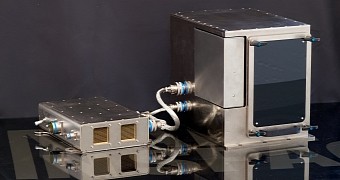It was just four days ago that NASA sent out the first space-worthy 3D printer, and now the shuttle carrying that particular cargo has finally docked with the International Space Station, or ISS for short.
This marks the beginning of humankind's space age, or that's one way to look at this. It will be a long time before we can actually produce ships and other, truly relevant constructs in space, but at least we've finally started on that journey.
Not that the current approach is all that ideal. There is one problem that we will have to surmount before anything truly grand is accomplished: material support.
The Made in Space Zero-G 3D printer uses plastic
This is enough of a problem even on Earth, where gravity is still very much present and strong: 3D printing sessions give off loads of cobwebs.
We can only imagine the horror that will become in orbit, where gravity is almost nonexistent. Admittedly, the 3D printer has a closed build chamber, but even the best ventilation might miss a few flakes, which will drift out once you open the hatch.
The bigger problem, however, is that plastic is a compound that can only be made from organic sources. Which is to say, it can't be produced from raw minerals.
Thus, if anything is to be made in space, NASA will need to keep ferrying supplies (material packs as it were) to the ISS over the years.
It mostly defeats the purpose of the whole thing really: to reduce the need for and frequency of rockets that need to be sent off. It takes a lot of cash (manpower, expensive fuel) to ready and successfully launch even one rocket after all.
Then again, NASA and Made in Space did say that the Zero-G 3D printer was only the very first, small step towards becoming a spacefaring race. In time, we're certain that metal and other materials will be supported. It makes the idea of relying on asteroid-mined resources actually viable. But back to the matter at hand.
The SpaceX Dragon supply freighter has docked with the ISS
This happened yesterday, September 23. The printer was delivered into the hands of the astronauts along with 5,000 pounds / 2,267 kilos of supplies, not all of which were 3D printing related (there were even some mice and flies, for other kinds of research).
The 3D printer won't be installed immediately though, since the astronauts have a schedule and other duties to see to.

 14 DAY TRIAL //
14 DAY TRIAL //